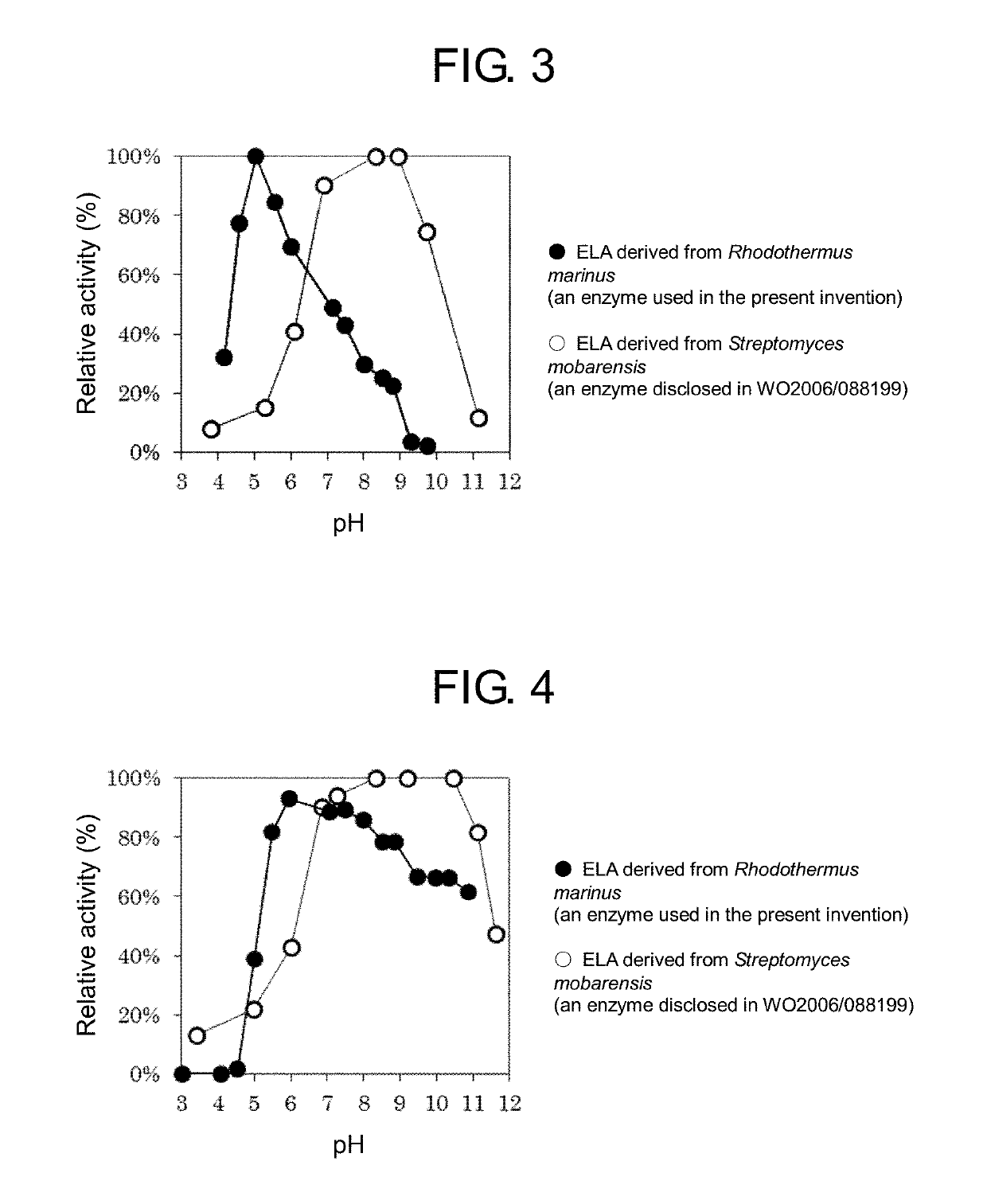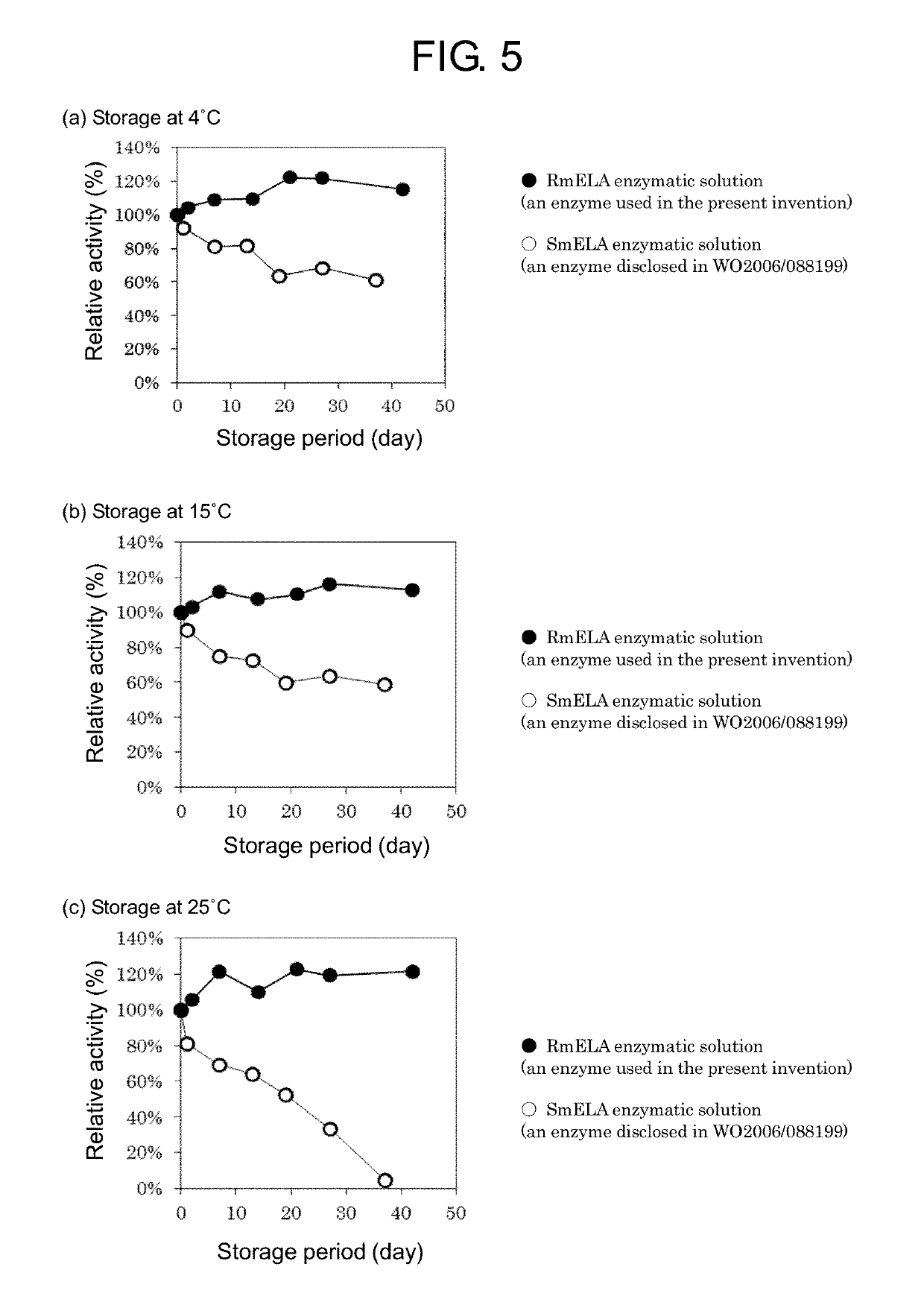Method for producing Nε-acyl-L-lysine
a technology of acyl-l-lysine and acyl-l-lysine, which is applied in the direction of enzymes, biochemistry apparatus and processes, fermentation, etc., can solve the problems of inability to meet the performance of conventional enzymes in the industrial production of n-dodecanoyl-l-lysine, lack of stability of conventional enzymes, and complicated process to separate the compounds from each other, etc., to achieve excellent long-term reactivity, excellent heat resistan
- Summary
- Abstract
- Description
- Claims
- Application Information
AI Technical Summary
Benefits of technology
Problems solved by technology
Method used
Image
Examples
example 6
tion of RmELA Expression Strain with Enzyme Activity Maintained
[0201]Whether a C. glutamicum expression strain of RmELA could be sterilized with heat while maintaining the enzyme activity was examined. The culture solution acquired by the method described in Example 1, 1-6) in an amount of 150 μl was dispensed to a PCR tube and was subjected to heat treatment at 75° C. for 30 minutes using a block heater to obtain a heat treatment culture solution. The heat treatment culture solution and the heat treatment culture solution serially diluted (with a dilution rate of ×102) with a physiological saline solution (0.85% of NaCl) were applied to a CM2G agar medium (10 g of a yeast extract, 10 g of polypeptone, 5 g of glucose, 5 g of sodium chloride, 0.2 g of DL-methionine, 15 g of agar, pH 7.2, and filled up to 1 L with water) containing 25 mg / l of kanamycin, and the number of formed colonies was counted to examine the number of living bacteria of the RmELA expression strain. As a result, n...
example 7
tability of Rm-ELA
[0204]A culture solution of the C. glutamicum expression strain of RmELA acquired by the method described in Example 1, 1-6) was centrifuged to collect the supernatant, which was membrane-sterilized with a 0.45 μm filter to obtain an RmELA enzymatic solution. A WDK010 / pPKT-tatABC strain (WO 2010 / 067871) as a C. glutamicum expression strain of ELA native to Streptomyces mobarensis (SmELA) was cultured and sterilized by a similar procedure to obtain an SmELA enzymatic solution.
[0205]These enzymatic solutions were stored at temperatures of 4° C., 15° C., and 25° C., and the transition of enzyme activity was examined. The results are shown in FIG. 5. The activity was represented as relative activity (%) with the activity value when the storage started as 100. The RmELA enzymatic solution did not decrease in enzyme activity in all the storage temperatures. In contrast, the SmELA enzymatic solution tended to decrease in enzyme activity as the number of days of storage pa...
example 8
of Nε-dodecanoyl-L-lysine by RmELA Enzymatic Solution
[0207]Using the RmELA enzymatic solution prepared by the method described in Example 7, the synthesis reaction of Nε-dodecanoyl-L-lysine was carried out. A 200 ml of a reaction solution was prepared so as to give final concentrations of 300 mmol / L dodecanoic acid, 300 mmol / L L-lysine hydrochloride, 0.1 mmol / L ZnSO4, 10% methanol, and 3 U / ml the RmELA enzymatic solution and was stirred at 300 rpm using a 500 ml jar fermenter. The pH was adjusted to be 7.0 using 1 N of NaOH, and the reaction temperature was adjusted to be 55° C.
[0208]During the reaction, the reaction solution was sampled over time, and an L-lysine concentration within the reaction solution was measured, revealing that 98% of the charged L-lysine was consumed after 24 hours (FIG. 6, with the lysine concentration at the start of the reaction as 100%). When the reaction solution after 24 hours was analyzed by HPLC, Nε-dodecanoyl-L-lysine was produced by 98% in terms of...
PUM
| Property | Measurement | Unit |
|---|---|---|
| temperature | aaaaa | aaaaa |
| temperature | aaaaa | aaaaa |
| temperature | aaaaa | aaaaa |
Abstract
Description
Claims
Application Information
 Login to View More
Login to View More - R&D
- Intellectual Property
- Life Sciences
- Materials
- Tech Scout
- Unparalleled Data Quality
- Higher Quality Content
- 60% Fewer Hallucinations
Browse by: Latest US Patents, China's latest patents, Technical Efficacy Thesaurus, Application Domain, Technology Topic, Popular Technical Reports.
© 2025 PatSnap. All rights reserved.Legal|Privacy policy|Modern Slavery Act Transparency Statement|Sitemap|About US| Contact US: help@patsnap.com



